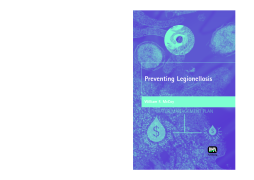
Additional Information
Book Details
Abstract
Preventing Legionellosis covers the biology of Legionella and presents a comprehensive review of best practices for legionellosis prevention from around the world. Recent outbreaks, climbing incidence rates and pending lawsuits have raised public awareness about legionellosis, a serious, preventable form of pneumonia that can be contracted from water systems in buildings. Legionellosis has harmed millions of people worldwide and causes annual monetary losses in the billions. However, to really understand the effects of the disease, one must listen carefully as the victims, or their survivors, describe the suffering they have endured. Preventing Legionellosis provides concise detail for: Improving awareness and education Implementing water management plans Mitigating against commercial conflict of interest The book will give the scientific basis for the worldwide technical consensus on the prevention of legionellosis. It will be an invaluable source of information for public health administrators, epidemiologists, infection control professionals, facility safety managers, industrial hygienists, and academic engineers and scientists.
Table of Contents
| Section Title | Page | Action | Price |
|---|---|---|---|
| Preventing Legionellosis | ii | ||
| Contents | vi | ||
| Preface | x | ||
| Acknowledgements | xii | ||
| Part One Legionellosis | 1 | ||
| 1. Cost | 3 | ||
| 1.1 Cost estimate | 3 | ||
| 1.2 Personal accounts of acute and long-term illness | 4 | ||
| 1.3 Personal injury, criminal negligence, and corporate manslaughter | 8 | ||
| 2. Cause | 11 | ||
| 2.1 The pathogen | 11 | ||
| 2.1.1 Discovery | 11 | ||
| 2.1.2 Cell biology | 12 | ||
| 2.2 The host | 18 | ||
| 2.2.1 Protists | 18 | ||
| 2.2.2 Mammalian phagocytes | 20 | ||
| 2.3 Life cycle | 20 | ||
| 2.3.1 Infection | 25 | ||
| 2.3.2 Rapid intracellular growth | 25 | ||
| 2.3.3 Lysis | 28 | ||
| 2.3.4 Ecological significance | 28 | ||
| 2.4 Motive to control protist hosts | 30 | ||
| 3. Effect | 31 | ||
| 3.1 Pathogenicity | 31 | ||
| 3.1.1 Infectivity factors | 32 | ||
| 3.1.2 Incubation period summary | 35 | ||
| 3.2 Diagnosis and therapy | 37 | ||
| 3.2.1 Case definition | 37 | ||
| 3.2.2 Antibiotic therapy | 38 | ||
| 3.2.3 Trends | 39 | ||
| 4. Extent | 40 | ||
| 4.1 Incidence rates | 40 | ||
| 4.1.1 Demographics | 41 | ||
| 4.1.2 Pneumonia | 41 | ||
| 4.2 Epidemiology | 47 | ||
| 4.2.1 Sources | 47 | ||
| Part Two Prevention | 49 | ||
| 5. Guidance | 51 | ||
| 5.1 Codes of practice | 51 | ||
| 5.2 Laws, regulations, and standards | 51 | ||
| 5.2.1 Government-approved or sponsored codes of practice | 52 | ||
| 5.2.2 The United Kingdom | 52 | ||
| 5.2.3 Australia/New Zealand and Asia Pacific | 54 | ||
| 5.2.4 Europe | 55 | ||
| 5.2.5 The United States of America | 57 | ||
| 5.3 A global code of practice | 58 | ||
| 6. Hazard analysis | 60 | ||
| 6.1 Putting it into perspective:water management plans and budgets | 60 | ||
| 6.2 The WSP | 61 | ||
| 6.2.1 Using WSPs to prevent legionellosis | 61 | ||
| 6.2.2 Developing a WSP to prevent legionellosis | 62 | ||
| 6.2.3 Risk characterization in the WSP system | 62 | ||
| 6.3 The HACCP system | 66 | ||
| 6.3.1 HACCP system principles | 67 | ||
| 6.3.2 The HACCP plan and supporting documents | 68 | ||
| 6.3.3 Process flow diagrams | 68 | ||
| 6.3.4 Hazard analysis and risk assessment | 70 | ||
| 6.3.5 CCPs | 78 | ||
| 6.3.6 Validation, verification, and reassessment of the plan | 79 | ||
| 6.3.7 The HACCP plan document: control limits, monitoring, frequency, corrective actions, and verification schedule | 79 | ||
| 6.3.8 Disease prevention with HACCP | 80 | ||
| 6.3.9 A history of the HACCP system | 81 | ||
| 6.3.10 A cost–benefit analysis of HACCP in USA | 84 | ||
| 6.3.11 Biological hazard control in the food industry | 85 | ||
| 7. Hazard control | 86 | ||
| 7.1 Hazard control in potable water systems | 87 | ||
| 7.1.1 Hazard control in domestic hot water systems | 87 | ||
| 7.1.2 Hazard control in domestic cold water systems | 89 | ||
| 7.1.3 Hazard control in heating ventilation and air-conditioning systems | 90 | ||
| 7.1.4 Hazard control in the peripheral water system | 90 | ||
| 7.1.5 Thermal disinfection and inhibition of growth | 94 | ||
| 7.1.6 Secondary disinfection of potable water systems | 94 | ||
| 7.2 Hazard control in utility water systems | 101 | ||
| 7.2.1 Cooling water systems | 101 | ||
| 7.3 Hazard control in potting soil | 106 | ||
| 8. Validation and verification | 108 | ||
| 8.1 Validation | 108 | ||
| 8.1.1 Quantitative analysis of the hazard | 109 | ||
| 8.2 Verification | 115 | ||
| Conclusions | 117 | ||
| Bibliography | 119 | ||
| Index | 135 |
